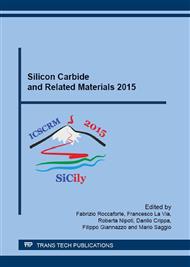p.449
p.453
p.457
p.461
p.465
p.469
p.473
p.477
p.481
Mechanisms of Nitrogen Incorporation at 4H-SiC/SiO2 Interface during Nitric Oxide Passivation – A First Principles Study
Abstract:
In this work, we investigate the behavior of Nitrogen atoms at 4H-Silicon Carbide (4H-SiC)/Silicon dioxide (SiO2) interface during nitric oxide passivation using ab-initio Density Functional Theory. Our calculations suggest different possible energetically favorable and competing mechanisms by which nitrogen atoms could a) incorporate themselves into the oxide, just above the 4H-SiC substrate, and b) substitute for carbon atoms at the 4H-SiC surface. We attribute the former process to cause increased threshold voltage instability (hole traps), and the latter to result in improved effective mobility through channel counter-doping, apart from removing interface traps in 4H-SiC power MOSFETs. These results support recent electrical and XPS measurements. Additionally, Nitric Oxide passivation is shown to energetically favor re-oxidation of the 4H-SiC surface accompanied by the generation of oxygen vacancies under the conditions considered in this work.
Info:
Periodical:
Pages:
465-468
Citation:
Online since:
May 2016
Authors:
Price:
Сopyright:
© 2016 Trans Tech Publications Ltd. All Rights Reserved
Share:
Citation:


